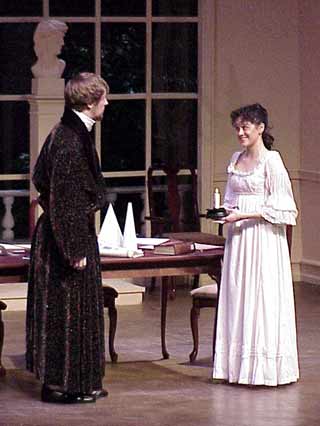PRODUCTION STAFF
Technical Director Douglas
W. Brown
Costume Shop Supervisor Lisa
Weller
Audience Services Coordinator
Shanda Smith
Dramaturgical Assistance
Kelly Gidcumb
Assistant Stage Managers
Katie Krauss, Mark Sherriff
Assistant Lighting Designer
Matt Nelkin
Master Carpenter Matt
Fuller*
Scene Shop Assistants Aaron
Bokros*, Bill Diggle*
Matt Fuller*, Sarah Storminger*
Props Master K.T. Early
Scenery & Props Crew
Megan Anderson,
Jarrod Atchison, Neil Bloomfield,
Ryan Braun,
Scott Cooper, Ian Doody, Jonathan
Hall,
Mike Maltarich, Matt Price,
Rick Price, Lawrence Russell, Bryan Watts, Bryan Windham, Andy Yates
Cutter/Draper Lisa Weller
Costume Shop Assistants Charles
Compton,
K.T. Early, Katherine Lewis,
Sara Wakild,
Pamela Yeager
Costume Construction Crew
Chrissi Anderson
Megan Carr, Julia Kyle, Eddie
Lindler
Liz Metz, Tyler Overstreet,
LaTisha Pearson
Adrienne Powell, Julia Schmidt
Wardrobe, Hair & Makeup
Meg McKee
Lightboard Operator Lauren
Thompson*
Electrics Crew Matt Fuller*,
Alan English
Brook Flynn, Eamonn Haley,
Colleen McNickle
Dan Meisenheimer, Jamal Seale,
Patrick Swanson
Rafael Vidaurreta, Bo Walker
Sound Design & Engineering
Mike Albanese
Sound Board Operator Chrissy
Davis
Poster Design Jimmy Hilburn
Photography Bill Ray
III
Homepage Photography
Jonathan Christman
Publicity Assistants
Meghan Higgins*, Kelly Murdoch-Kitt*
Assistant House Manager Elizabeth
Rief Cheek
Box Office & Front of
House Staff Ali Ayala
Emily Duggins, Kristen Franke
Alan Susi, Cammie Wilson*
Front of House Crew Drew
Dayton
Kristin Johnson, Patrick Mariani,
Clay Murdy
Mary Kate Mastrangelo, Tim
Reeder
Theatre Office Assistants
Alan English, Nathan Gunter, Nick Kinder, Jen Phillips, Jamelle Shannon,
Tanis Smith, Nick Spruill, Amber Wiley*, Michael Wright
* Member of The Anthony
Aston Players
SPECIAL THANKS
Professor John Baxley
Robert Simpson
North Carolina School of
the Arts
North Carolina Shakespeare
Festival
UNC-Chapel Hill

|












